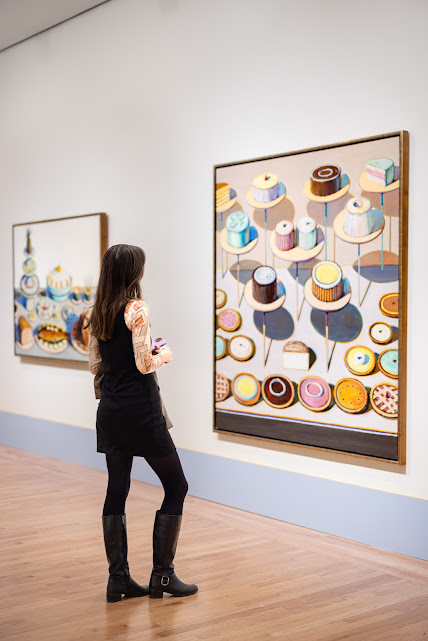I like to say that the only truly original artist was the man or woman who drew that first mastodon on the cave wall. All other artists have been stealing from that person ever since. Wayne Thiebaud, currently the subject of a wonderful exhibition at the California Palace of the Legion of Honor in San Francisco, would agree with me. The exhibition, “Art Comes From Art,” foregrounds a practice grounded in his statement, “I believe very much in the tradition that art comes from art and nothing else.”
Thiebaud still gets mentioned in discussions of Pop Art, but, as Timonthy Burgard, Senior Curator at the de Young Museum points out in the exhibition’s accompanying video, Thiebaud has none of the irony that suffuses the work of Andy Warhol, Roy Lichtenstein, or Tom Wesselman, and his paintings have none of the flatness that characterizes Warhol’s silk screens, Lichtenstein’s Ben Day dots, or Wesselman’s collaged works. Thiebaud was in love with oil; all of his subjects are caressed with delicious impasto.

Installation view of Wayne Thiebaud Art Comes From Art exhibition, 2025.
Photo by Gary Sexton. Image courtesy of the Fine Arts Museums of San Francisco.
Thiebaud was from a working-class background and first studied art at a trade school in Los Angeles. Following service in World War II, he attended state colleges in San Jose and Sacramento. His first art mentor was the head of the advertising department at the Los Angeles firm for which he worked.
Thiebaud was never ashamed of his roots in commercial art; indeed, as he once quipped, “I don’t care much for Pop Art. It’s too close, I think, to advertising, which I think is better.”
Thiebaud had a passionate interest in art history, however, and began teaching soon after receiving his master’s degree. He would continue to teach for the rest of his life, the longest stint being at the University of California at Davis. A leave of absence from teaching during the 1956-57 school year allowed Thiebaud to spend time in New York, where he was befriended by Willem De Kooning and Franz Kline.
Like the best teachers, Thiebaud was a lifelong student as well, one who made his own small copies of the Old Master paintings he loved, several of which are included in the exhibition. A major tribute to the artists Thiebaud admired is a large painting, 35 Cent Masterworks, which shows a rack of 12 postcards depicting works from artists as varied as Diego Velasquez and Willem De Kooning.
The nod to De Kooning is a key to understanding Thiebaud’s work. Because of his subject matter (cakes, lollypops, gumball machines), Thiebaud was included in the 1962 exhibition at Sidney Janis Gallery in New York which is credited with introducing Pop Art to New York audiences. That same year, he was included in a significant exhibition entitled New Painting of Common Objects, organized by noted curator Walter Hopps for the Pasadena Art Museum (now the Norton Simon Museum), which brought nationwide attention to the movement.
But while Thiebaud was initially yoked to Warhol et al, he really belongs to a group of West Coast artists such as David Park, Richard Diebenkorn, and Elmer Bischoff, who began as Abstract Expressionists and then returned to recognizable subject matter while maintaining their painterly chops. This exhibition is about paint, not cakes and candy. The subject matter, however, certainly helps account for Thiebaud’s widespread popularity. His cake paintings have sold for seven and even eight figures at auction. A 17 x 21-inch oil of a slice of pie a-la-mode is expected to bring somewhere between $1,200,000 and $1,800,000 at a sale at Bonhams next week.
But you don’t need that kind of money to enjoy a lovely Thiebaud. The Legion of Honor show is on view until August 17. There are currently no plans for it to tour, so get yourself on a plane to San Francisco. You may or may not leave your heart there, but your eyes will come back thoroughly satisfied.

